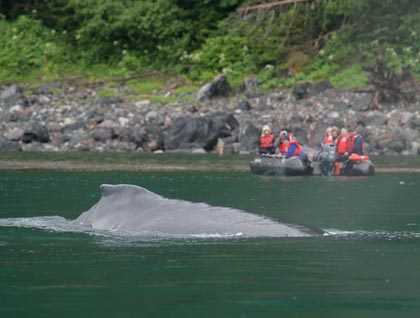Whew! What a jam-packed second day aboard the National Geographic Sea Bird! It all began around 6:00 a.m. when early risers took in the beautiful sights of Idaho Inlet, along with the first sightings of back-floating sea otters. Then, shortly before 7:00 a.m. came our expedition leader over the P.A… “Good morning ladies and gentlemen… this is a slightly early wake-up call because off the bow we have some humpback whales. It is currently cloudy and 52 degrees. I highly suggest you put on some layers and join us out on deck. Susan will begin her stretch class at 7…” About midway through the morning stretch, another announcement—“If you’re not out on deck you really should be because we have a WALL OF WHALES in front of the ship—at least 20 whales, with some breaching and tale lobbing… come on out and join us!” Hmmm, this was a no-brainer—stretch class dismissed! We stood on the portside, mesmerized by two dozen whales breathing and diving and pec-slapping, and tail-lobbing, and—best of all—baby breaching: two small whales hurling themselves high into the air, over and over again. It was almost like they were performing just for us! We stayed with the whales for half an hour, delaying our breakfast to watch them have theirs. Wow. And all this with a backdrop of layers and veils of clouds and mist clinging to the landscape and water and sky, some of it sprinkling down on the decks and us. What a magnificent welcome to Cross Sound at the head of Icy Strait, the northern entrance to the Inland Passage.
We spent our day exploring this biologically rich area. First stop: George Island, a beautiful piece of Southeast Alaskan rain forest and the site of WWII gun emplacement designed to protect this strategic waterway. All ashore were treated to the low tide-pooling creatures, including barnacles, crabs, and sea stars. Longer hikes walked up to the cannon, while shorter hikes crossed the narrow island to the beach on the other side. Kayakers and expedition landing craft cruises explored the shoreline’s waterways and high cliff walls. Rain continued to fall in varying degrees, but it didn’t seem to faze anyone.
Next stop: Elfin Cove, a tiny boardwalk fishing village with a year-round population of less than 12. One of the residents came aboard and regaled us with stories of life here, the joys and challenges of raising a family in such a unique environment. After lunch we had the opportunity to stroll through the town.
When we were back aboard, the ship repositioned a few miles—passing through the wall of feeding whales again!—to anchor for our final destination of the day. The Inian Passage is the constricted waterway at the entrance to the Inside Passage through which a huge amount of water flows, as the tides change every 6 hours. It is one of the most productive marine areas in the world with phytoplankton-rich emerald green waters that attract all manner of fish, which in turn attract sea birds, eagles, and marine mammals. The surrounding Inian Islands are home to a variety of sea birds, a haul out for steller sea lions, and kelp bed habitat for sea otters. Small boat cruises brought us through this washing machine of currents, and we got great looks at all of these creatures, plus more humpback whales! What an amazingly fun and adventurous ride.
As I’m writing, we are gathered in the lounge for recap, tasting local wines and chocolates. Kids are getting ready for pizza and a movie. And after dinner, I suspect, we will be getting underway, needing to go through that wall of whales yet again, as we head east and then north towards tomorrow’s adventures in Glacier Bay National Park.






